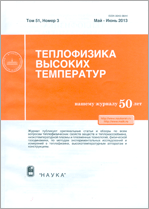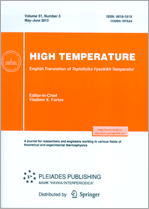|
Plasma Investigations
Mathematical model of the diffusion mode of a short, high-current vacuum arc in the axial magnetic field
T. M. Sapronova, K. N. Ulyanov
All-Russia Electrotechnical Institute, Branch of the Zababakhin All-Russia Scientific Research Institute of Technical Physics Russian Federal Nuclear Center, Moscow, 111250 Russia
Abstract:
In this paper, a theory of a diffuse mode of an axially symmetric short high-current vacuum arc in an external axial magnetic field is developed. A second-order partial differential equation for the lines of discharge current levels ($2\rm D$ model) is obtained. The boundary conditions at the cathode and anode boundaries of the plasma are formulated. The solution of this equation with allowance for the heat-balance equation for electrons and the equation for the plasma concentration makes it possible to determine the dependence of streamlines on the coordinates. With these lines, the obtained analytical formulas can be used to calculate the components of the current density, magnetic field, and the distribution of the electron temperature and plasma concentration in the discharge gap. A $(1.5\rm D)$ mathematical model $(j_r \ll j_z)$ that significantly simplifies the calculations and has a sufficiently wide range of applicability is proposed and substantiated. The method of successive approximations, which ensures results with the required accuracy, is used in the calculations for this model. The distributions of the components of the magnetic field $B_r$, $B_{\theta}$, and $B_z$, the current density $(j_r$, $j_z$, and $j_{\theta})$, the distributions of the electron temperature, and the concentrations of electrons and ions in the plasma of a vacuum arc are calculated.
Received: 25.04.2019
Revised: 19.02.2020
Accepted: 10.03.2020
Citation:
T. M. Sapronova, K. N. Ulyanov, “Mathematical model of the diffusion mode of a short, high-current vacuum arc in the axial magnetic field”, TVT, 58:6 (2020), 844–855; High Temperature, 58:6 (2020), 761–772
Linking options:
https://www.mathnet.ru/eng/tvt11174 https://www.mathnet.ru/eng/tvt/v58/i6/p844
|


| Statistics & downloads: |
| Abstract page: | 91 | | Full-text PDF : | 66 |
|





 Contact us:
Contact us: Terms of Use
Terms of Use
 Registration to the website
Registration to the website Logotypes
Logotypes








 Citation in format
Citation in format 